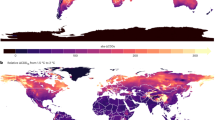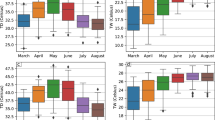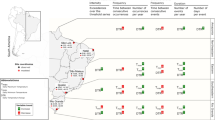Abstract
A human body may be able to adapt to extremes of dry-bulb temperature (commonly referred to as simply temperature) through perspiration and associated evaporative cooling provided that the wet-bulb temperature (a combined measure of temperature and humidity or degree of ‘mugginess’) remains below a threshold of 35 °C. (ref. 1). This threshold defines a limit of survivability for a fit human under well-ventilated outdoor conditions and is lower for most people. We project using an ensemble of high-resolution regional climate model simulations that extremes of wet-bulb temperature in the region around the Arabian Gulf are likely to approach and exceed this critical threshold under the business-as-usual scenario of future greenhouse gas concentrations. Our results expose a specific regional hotspot where climate change, in the absence of significant mitigation, is likely to severely impact human habitability in the future.
This is a preview of subscription content, access via your institution
Access options
Subscribe to this journal
Receive 12 print issues and online access
$209.00 per year
only $17.42 per issue
Buy this article
- Purchase on Springer Link
- Instant access to full article PDF
Prices may be subject to local taxes which are calculated during checkout



Similar content being viewed by others
References
Sherwood, S. C. & Huber, M. An adaptability limit to climate change due to heat stress. Proc. Natl Acad. Sci. USA 107, 9552–9555 (2010).
Boden, T. A., Marland, G. & Andres, R. J. (eds) Global, Regional, and National Fossil-Fuel CO2 Emissions (Oak Ridge National Laboratory, US Department of Energy, 2013).
IPCC Climate Change 2013: The Physical Science Basis (eds Stocker, T. F. et al.) (Cambridge Univ. Press, 2013).
Hewitson, B. C. et al. in Climate Change 2014: Impacts, Adaptation, and Vulnerability (eds Barros, V. R. et al.) Ch. 21 (IPCC, Cambridge Univ. Press, 2014).
Bindoff, N. L. et al. in Climate Change 2013: The Physical Science Basis (eds Stocker, T. F. et al.) Ch. 10, 867–952 (IPCC, Cambridge Univ. Press, 2013).
Marcella, M. P. & Eltahir, E. A. B. Effects of mineral aerosols on the summertime climate of southwest Asia: Incorporating subgrid variability in a dust emission scheme. J. Geophys. Res. 115, D18203 (2010).
Marcella, M. P. & Eltahir, E. A. B. Modeling the hydroclimatology of Kuwait: The role of subcloud evaporation in semiarid climates. J. Clim. 21, 2976–2989 (2008).
Marcella, M. P. & Eltahir, E. A. B. The hydroclimatology of Kuwait: Explaining the variability of rainfall at seasonal and interannual time scales. J. Hydrometeorol. 9, 1095–1105 (2008).
Marcella, M. P. & Eltahir, E. A. B. Modeling the summertime climate of Southwest Asia: The role of land surface processes in shaping the climate of semiarid regions. J. Clim. 25, 704–719 (2011).
Rogers, R. R. & Yau, M. K. A Short Course in Cloud Physics (Pergamon, 1989).
Diffenbaugh, N. S., Pal, J. S., Giorgi, F. & Gao, X. Heat stress intensification in the Mediterranean climate change hotspot. Geophys. Res. Lett. 34, L11706 (2007).
Dunne, J. P., Stouffer, R. J. & John, J. G. Reductions in labour capacity from heat stress under climate warming. Nature Clim. Change 3, 563–566 (2013).
Fischer, E. M. & Schar, C. Consistent geographical patterns of changes in high-impact European heatwaves. Nature Geosci. 3, 398–403 (2010).
Luber, G. & McGeehin, M. Climate change and extreme heat events. Am. J. Prev. Med. 35, 429–435 (2008).
Parsons, K. Heat stress standard ISO 7243 and its global application. Ind. Health 44, 368379 (2006).
El Fadli, K. I. et al. World Meteorological Organization assessment of the purported world record 58 °C temperature extreme at El Azizia, Libya (13 September 1922). Bull. Am. Meteorol. Soc. 94, 199–204 (2013).
Cerveny, R. S., Lawrimore, J., Edwards, R. & Landsea, C. Extreme weather records. Bull. Am. Meteorol. Soc. 88, 853–860 (2007).
Meinshausen, M. et al. The RCP greenhouse gas concentrations and their extensions from 1765 to 2300. Climatic Change 109, 213–241 (2011).
Rodwell, M. J. & Hoskins, B. J. Monsoons and the dynamics of deserts. Q. J. R. Meteorol. Soc. 122, 1385–1404 (1996).
Thomson, A. et al. RCP4.5: A pathway for stabilization of radiative forcing by 2100. Climatic Change 109, 77–94 (2011).
Riahi, K. et al. RCP 8.5—A scenario of comparatively high greenhouse gas emissions. Climatic Change 109, 33–57 (2011).
World Population Prospects: The 2012 Revision, Methodology of the United Nations Population Estimates and Projections Working Paper No. ESA/P/WP.235 (United Nations, Department of Economic and Social Affairs, Population Division, 2014).
Sailor, D. Air conditioning market saturation and long-term response of residential cooling energy demand to climate change. Energy 28, 941–951 (2003).
Acknowledgements
This research was supported by the Kuwait Foundation for the Advancement of Science (KFAS). The NASA SRB were obtained from the NASA Langley Research Center Atmospheric Sciences Data Center NASA/GEWEX SRB Project.
Author information
Authors and Affiliations
Contributions
E.A.B.E. conceived the study with input from J.S.P. Both authors were involved in design of the research, interpretation of the results, and discussion of implications. J.S.P. performed the simulations, analysed the data and created the figures. Both authors contributed equally to the writing and revision of the manuscript.
Corresponding author
Ethics declarations
Competing interests
The authors declare no competing financial interests.
Supplementary information
Rights and permissions
About this article
Cite this article
Pal, J., Eltahir, E. Future temperature in southwest Asia projected to exceed a threshold for human adaptability. Nature Clim Change 6, 197–200 (2016). https://doi.org/10.1038/nclimate2833
Received:
Accepted:
Published:
Issue Date:
DOI: https://doi.org/10.1038/nclimate2833
This article is cited by
-
Future changes in the precipitation regime over the Arabian Peninsula with special emphasis on UAE: insights from NEX-GDDP CMIP6 model simulations
Scientific Reports (2024)
-
Thermal Tolerance of the Shallow-Water Ostracod Cyprideis from a Lagoon in Bahrain, Western Arabian Gulf
Arabian Journal for Science and Engineering (2024)
-
Geospatial modelling of drought patterns in Oman: GIS-based and machine learning approach
Modeling Earth Systems and Environment (2024)
-
Long-term air temperature trends in North Cyprus
Theoretical and Applied Climatology (2024)
-
Understanding systemic cooling poverty
Nature Sustainability (2023)



